Location
The church was originally sited on Lion Gate Road at the junction with Fountain Street (now Edinburgh Road), on land later known as the site of The Arcade. A permanent building was later erected in Surrey Street. This was largely destroyed in WW2 and although the adjacent small hall was used after the war, the church itself finally closed in 1951. A branch of the National Westminster Bank now stands on part of the site formerly occupied by the church.
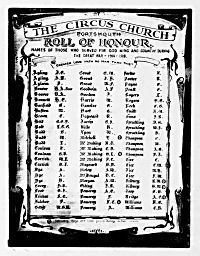
Circus Church (1)
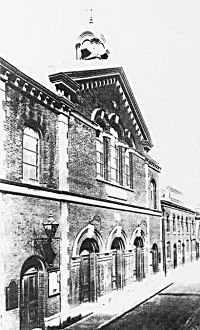
Circus Church (2)
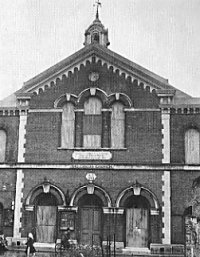
Church Interior
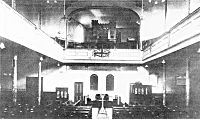
Original Church
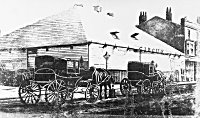
Church Interior
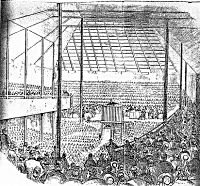
Plaque
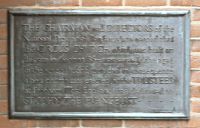
THE CIRCUS CHURCH
PORTSMOUTH
ROLL OF HONOUR
NAMES OF THOSE WHO SERVED FOR GOD, KING AND COUNTRY DURING THE GREAT WAR 1914 - 1918
GREATER LOVE HATH NO MAN THAN THIS
|
Ayling D.E. Ayling A.R. Aylwin B. Beaver H.A.Senr Beaver H.A. Bennett H.E. Banfield G. Bufton M. Brown E. Bolt E.E.F. Bolt I.G.G. Budd S. Budd W. Budd I. Coulson T. Coulson G. Carrick M. Carrick D. Dye A. Dye A. Dye H. Every H. Foot G. Fricker S.C. Fulcher P. Gasp W.G.H. |
Grout E.M. Grout D.H. Grout W.F. Goodwin A.F. Gordon J. Harris W. Hansler G. Hart G. Hayward R. Jarvis G. Kille H. Lyon W. Mitchell J.* McMaking R.T. McMaking C.D. McMaking O.J.* McMaking P.C. Maynard H.D. Meloy A.W. McDougal D.C. Morgan A.W. Olding J.A. Pomeroy A.E. Pomeroy J. Pomeroy J.C.* Pomeroy A. |
Porter J. Porter R. Payne E. Pratt E. Rogers J. Rogers H.E. Reek C.G. Smith R.W. Sims D.R. Sprackling D.G. Sprackling W. Sprackling D. Thompson C. Thompson W. Thompson A.G. Thompson P. Tier E. Tier C.W. Tier W.H. Tier J.W. Tilbury R.W.* Tilbury H.W.* Toop S. Uridge A.E.* Williams R.E. Williams C.H. |
| ||
Further Information
This Roll of Honour is typical of those erected in churches around the country at the outbreak of war in 1914. It didn't list those who lost their lives but rather those who volunteered to join the army. Later of course as the names of the dead became known their sacrifice was indicated on the Roll. What is unusual about this Roll is that it comes from a church with no parish, it's congregation being drawn from perhaps two or three surrounding parishes each of which may have had their own Rolls of Honour. The only one we know of for certain is the Parishioners Memorial at St Wilfrid's Church.
Supporting evidence for the inter-parochial nature of the congregation has been provided by Jennifer Stringer who has pointed out that Tilbury HW and Tilbury RW also appear on the WW1 memorial in St Simons Church. Both names also appear on the Cenotaph in Guildhall Square.
A Second Memorial
An e-mail from Mark Stephens tells us that his great-grandfather, Captain Prescot William Stephens, who was captain of HMS Thetis and died at sea in 1882, was remembered on a memorial erected in the Circus Church. We have no further information about this.
History of the Church
In the 1850s, the principle church in Portsea was St John's, but the parson, Rev. John G.F. Knapp was unhappy about existing class divisions which meant that his church was used very largely by the middle classes. Reverend Knapp decided to provide a place where the Gospel could be preached to all persons, free of charge and without collection. The site he chose was most unusual in that it was a wooden version of a circus big-top. The building was not within the parish of St John's and was never consecrated but it drew crowds in their thousands from the moment it was opened on June 7th 1857. By 1859, the Circus Church Sunday School had 41 teachers and 324 children attending.
In 1859 Reverend Knapp was joined by the Rev. John Cutlack Martin who at a meeting in 1863 agreed to co-ordinate the construction of a new church. In fact Martin largely paid for the new brick church himself and continued to run the church for 42 years without pay until his death in 1904. The new church was built in Surrey Street and was completed in 1864. It had seating for some 1700 people and had galleries on three sides, one of which held the organ. In 1939 significant alterations were made but just two years later the church was bombed and extensively damaged. Although some reconstruction took place in 1949 by 1951 it was decided that the cost of full restoration was too high and that those served by the church could be equally well served by other local churches. The site was sold for £10,500 and the money used was later spent on building St John's in Fareham. A plaque (see photo left and transcription below) now stands on the site of the church. It is situated to the right of the staff entrance to the Nat West (formerly National Provincial) Bank, on Surrey Street.
Transcription
National Provincial Bank wish to record that
the CIRCUS CHURCH which was built on
this site in the year 1864, was severely damaged
in the second world war, and in consequence
a new church was erected by the TRUSTEES
at Fareham West End, and was dedicated to
ST. JOHN THE EVANGELIST.
